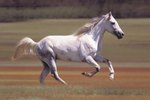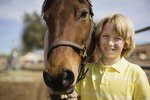
Horses are herd animals and it is natural for them to want to establish a herd-style hierarchy, whether they are in captivity or in the wild on a range. For the purposes of handling your horse, you need to be the dominant one in the relationship. A horse who thinks he is the boss can develop bad behaviors that can make him dangerous to handle. Recognizing your horse's attempts at establishing dominance is an essential part of correcting those same behaviors.
He Doesn't Listen to You
You tell your horse to whoa and he just keeps going. You try to lead him and he walks in front of you and proceeds to pull you to wherever he feels like going. A blatant disregard to your commands and instructions is often a sign of a dominance issue as well as a training issue. One of the most basic concepts of horse training is earning the horse's respect. If the horse does not respect you and feels he is dominant over you, he is going to do whatever he wants rather than what you want.
He's Pushy
Horses communicate with one another using body language. If your horse is constantly nudging at you, head butting you and generally using his body to move you around, he's exerting dominance over you. A common example of such behavior occurs when you're pouring his feed into his bucket and he uses his head to shove you out of the way as you're pouring rather than wait until you finish and move away. You can correct this behavior by refusing to yield and making the horse move away instead.
He's Aggressive
Pinned ears, lunging, charging, biting, kicking and a host of other aggressive behaviors are used by dominant horses in the wild to maintain order among the horses below them in the pecking order. When these behaviors are used towards a human, they can be very dangerous. When your horse displays aggressive dominant behaviors towards you, it is absolutely necessary that you be able to adequately correct the horse. If you do not have the skills to handle an aggressive horse, then you need to hire and work with a professional horse trainer to help correct the behavior.
Understanding Dominant Behavior
All horses will display some kind of dominant behavior towards either you or their pasture mates at some point in time. Even relatively passive horses may make an attempt to assert their dominance over humans when they are given the opportunity to do so. Consistent, confident handling will do a lot to reduce dominant behaviors. You need to be aware that even if your horse never tries to establish dominance with you, he may try with a less confident, less experienced handler and you should always supervise beginners and children who are handling your horse.
References
Photo Credits
-
John Foxx/Stockbyte/Getty Images
Writer Bio
Jen Davis has been writing since 2004. She has served as a newspaper reporter and her freelance articles have appeared in magazines such as "Horses Incorporated," "The Paisley Pony" and "Alabama Living." Davis earned her Bachelor of Arts in communication with a concentration in journalism from Berry College in Rome, Ga.




